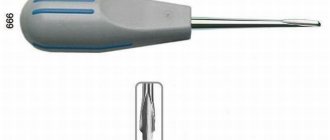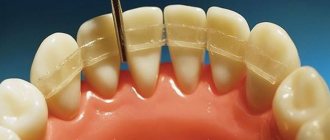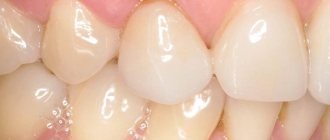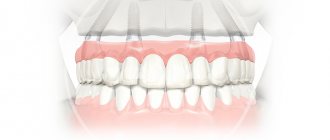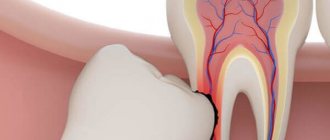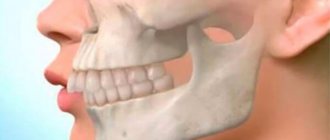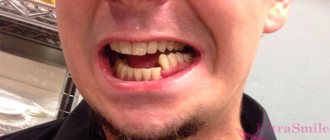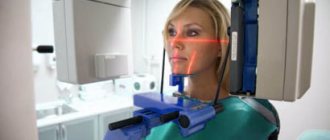Quite often, wisdom teeth cause problems to a person. They erupt at approximately the age of 20-25 years, when the dentition has already formed and in most cases their appearance is accompanied by complications. The extreme molars do not serve any useful function, so dentists often recommend that patients have them removed.
It should be understood that wisdom tooth extraction is a rather complicated procedure for both the doctor and the patient, especially the removal of molars on the lower jaw.
When you need to remove the bottom "eight". Indications
Wisdom teeth are distinguished by late eruption, which occurs at 20-30 years of age. During this period, the dental system is practically formed and the third molars often do not have enough space in the dentition. Eruption causes various complications and in most cases requires removal of the molar. In addition, in humans, with evolution, a decrease in the size of the jaws occurs, since, due to the nature of nutrition, the chewing load is constantly decreasing.
Most people do not take good hygienic care of their last teeth. They are located at the end of the dentition, and it is often technically impossible to clean them well. This leads to the accumulation of plaque, damage to the enamel by the carious process and its complications (pulpitis, periodontitis). Root canal treatment is very difficult due to difficult access. Therefore, eights must be removed in 90% of cases.
Removal of a fully erupted wisdom tooth
Removal of the lower wisdom tooth is indicated in the following cases:
- Excessive pressure on neighboring teeth, which can lead to their destruction;
- Injury to surrounding tissues;
- Constant biting of the mucous membrane of the cheek;
- Carious lesion that cannot be eliminated due to difficult access;
- Complications of caries: pulpitis, periodontitis, periostitis;
- Dystopia – location of the molar outside the dentition;
- A tooth that is a chronic source of infection;
- Formation of perihilar cysts, granulomas;
- Malocclusion and displacement of other teeth.
Diagnosis of dystopia
An orthodontist or even a dental therapist can easily determine tooth dystopia during a routine examination if the anomaly is not complex. In some cases, when an element of the dentition remains in the gum, ends up in the palate or another place, during the examination one can only suspect a problem.
If the doctor has not found one of the teeth that should have already erupted in a child (or an adult, if we are talking about eights), he will refer the patient for an x-ray examination. The picture clearly shows all the irregularities and you can see the formed teeth in the soft tissues. To clarify the position and for subsequent treatment, arthopantomography, creation of plaster models of the jaws, and teleradiography are used.
Removal of the lower impacted figure eight
A common complication is wisdom tooth retention, which is incomplete eruption. It can erupt above the gum as part of the crown or as one or two bumps. In this case, the second part of the crown will be covered with a gingival hood. With insufficient hygienic care, food accumulation, gum inflammation, and pericoronitis (inflammation of the hood) occur. In the case of pericoronitis, the dentist excises or cuts the gingival hood. But if the situation is constantly repeated and bothers you, then it is better to remove such a tooth. Chronic inflammation of the gums is a source of infection that spreads throughout the body and can provoke an exacerbation of other diseases.
Anesthesia
Before the operation, complete anesthesia of the required area of the jaw is carried out. The most commonly used is local anesthesia, which is carried out using a carpule syringe and an anesthetic. Anesthesia of the lower jaw occurs 8-10 minutes after the injection. The duration of the analgesic effect depends on the drug used and is 2-4 hours. The operation itself is completely painless, but after the anesthetic wears off, the patient begins to feel pain. Therefore, after the procedure, the specialist gives prescriptions about the need to use medications (painkillers, anti-inflammatory, antimicrobial agents).
Easy removal
Simple extraction is the extraction of a tooth without the use of additional tools or techniques. A simple operation is observed after complete eruption, correct positioning of the molar, and the absence of serious pathologies. The doctor applies forceps and, after rocking movements, removes the molar from the jaw
The following stages of the procedure can be distinguished:
- Anesthesia;
- Selection and preparation of tools;
- Tooth ligament separation;
- Application and fixation of forceps;
- Luxation of a molar;
- Extraction from bone;
- Checking the hole;
- Stop bleeding;
- Recommendations for the patient.
Difficult removal
Removing a wisdom tooth in the lower jaw is often difficult. The operation differs in its duration, the use of a special instrument, and the use of a drill. Often the tooth is sawed and removed in parts. In this case, the figure eight is incorrectly positioned or impacted. Removal consists of the following steps:
- High-quality pain relief;
- Preparation of tools and auxiliary materials;
- Separating the tooth ligament or creating access;
- Application and fixation of forceps;
- Extraction of a molar in whole or in parts;
- Inspection of the bone socket, cleaning it if necessary;
- Stop bleeding;
- Stitching;
- Prescriptions and recommendations for the patient.
Extraction methods
The standard method of removal for third molars is rarely used, only on the condition that eruption has proceeded normally, and the figure eight itself is in the correct position and has a normal root structure. Dentists at the Dentospas clinic recommend performing a more gentle and safe atraumatic removal of:
- after dissection of the gums or detachment of soft tissues, the tooth is divided into segments using a special tool;
- each of the segments along with the root is removed from the hole;
- the hole is processed, if necessary, stitches are applied.
Advantages:
- atraumatic removal is gentle on bone tissue. A small part of it can be removed if the molar is dystopic or impacted. Moreover, all manipulations are controlled, the doctor precisely regulates the volume of intervention, injury is minimal;
- if there are several roots, they have a non-standard location, are directed in different directions, and interfere with neighboring teeth, the atraumatic removal technique allows you to work separately with each of them. The root is removed safely, without damaging nearby tissues, regardless of its size, direction of growth, etc.;
- recovery after atraumatic removal is faster. It takes up to several days. The risk of complications is minimal.
At the Dentospas clinic, when removing wisdom teeth, precise diagnostics are used (to assess the position, number and condition of the roots, etc.). We perform third molar extraction using several methods. After the procedure, APRF technology can be used for faster healing.
Possible consequences after removal
Complications can occur after any surgical procedure. These include: bleeding from the wound, suture dehiscence, inflammation of the socket (alveolitis), increased body temperature over 38 degrees, numbness of the jaw, bone fragments or tooth remains in the socket.
A normal reaction of the body in response to surgery is the appearance of pain, discomfort, unpleasant sensations in the surgical area, a slight increase in temperature, swelling of the angle of the jaw, and facial asymmetry. These symptoms occur due to soft tissue injury, damage to blood vessels and nerve endings. The pain should subside over time and disappear after 5-10 days.
If after 3-4 days the pain does not decrease and the symptoms of inflammation increase, you should consult a dentist. The most unpleasant complication is alveolitis - inflammation of the socket of an extracted tooth. It manifests itself as acute pain, redness and swelling of the gum tissue, a significant increase in temperature, and general symptoms. The wound may discharge purulent contents or necrotic plaque. In this case, treatment by a dentist is necessary.
When is the best time to treat dental dystopia?
Like any dental disorder, dystopia should be treated immediately after the problem is discovered. The easiest time to change the position of teeth is during childhood and adolescence (up to about 18 years of age). This is due to the time of formation of the jaw bones. Until adulthood, the bone is still quite soft, which makes it easy to align the bite.
Sometimes, although rarely, trainers are used to treat dystopia. Read more about them in the article: Trainers for teeth straightening: description, varieties, tips for use
If we are talking about dystopic molars , then they are almost always removed. The third molars themselves are considered an atavism and an optional element in the dentition; moreover, their treatment is associated with problems and difficulties. Therefore, doctors do not try to save these teeth.
Sometimes treatment is associated not with removal, but with grinding of the tooth. This decision is made if the dystopic element does not interfere with the chewing function and does not violate the aesthetics of the oral cavity. In this case, it is recommended to be constantly monitored by a doctor, since such elements of the dentition are easily affected by caries. Moreover, the consequences are much more serious than in ordinary cases: incorrect tooth position stimulates the development of bacteria, inflammation, and complications.
Installation of braces for the treatment of canine dystopia
Prevention after surgery
After the last molar is removed, the specialist gives instructions that must be strictly adhered to. This is done to prevent complications, speed up wound healing and restore the body. The doctor recommends:
- Do not eat food for several hours after surgery;
- On the first day, you can apply a cold compress to reduce swelling and inflammation;
- For the first two days, you should not rinse your mouth, so as not to remove the blood clot from the hole from which healing will occur;
- Hygienic care can be carried out as usual; teeth in the surgical area should be brushed very carefully;
- Take painkillers and other medications prescribed by your doctor;
- From the second day, the mouth can be rinsed with antiseptic solutions, decoctions of medicinal herbs, and mouth rinse;
- It is recommended to eat soft foods, avoid too hard, spicy, hot foods;
- Bad habits (smoking, drinking alcohol) should be eliminated;
- During the week you cannot visit the sauna, bathhouse, or gym.
Useful tips
Before removing an incorrectly positioned wisdom tooth, we offer a number of tips that will help you prepare and go through the operation more comfortably:
- Try to make an appointment for tooth extraction in the morning. During the night, the hormone cortisol accumulates in the body, which helps to survive stressful situations. In addition, one should take into account the fact that the inevitable bleeding from the wound at the site of the former tooth will stop by the evening, and the person will be able to sleep peacefully.
- Eat well before surgery. As a result, saliva will be released in smaller volumes, and then you will need to leave your jaws alone and not eat for some time.
- If possible, immediately use a cold object and periodically apply it to your cheek on the way home to prevent swelling from forming. A pack of dry ice from a motorist's first aid kit will do.
- At home, rinse your mouth with clean water or medications recommended by your doctor.
- Take medications in the correct dosage, do not get carried away with self-medication and self-prescription of drugs.
Recommendations for a better rehabilitation period after removal of an impacted wisdom tooth:
- You will need to allow a blood clot to form at the site of the extracted tooth. His presence is mandatory. The clot protects the socket from the penetration of bacteria and prevents complete deformation of the gums. Dry socket is dangerous and provokes inflammation.
- Do not touch the blood clot with your tongue, toothbrush bristles, or cutlery. It is not even recommended to use mouth rinse for 2-3 days after surgery. It is better to take the medicine into your mouth, hold it for a while and spit, avoiding the chance of dislodging the clot.
- To stop bleeding, it is permissible to use sterile cotton wool or gauze swabs. It is allowed to moisten with Chlorhexidine, Miramistin. It is prohibited to use hydrogen peroxide!
- For several days you will have to eat soft food and maintain an acceptable temperature of food and drinks.
- You are supposed to temporarily give up physical activity and training. Baths and saunas, swimming pools, solariums are prohibited.
- You cannot heat the surgical area, as this will cause a dangerous inflammatory process. You can apply ice, but under no circumstances keep it on your cheek all the time. Optimal rhythm: 5 minutes cooling, 5 minutes break. If you don’t have ice at home, bags of frozen vegetables and meat from the freezer will do.
- Maintaining oral hygiene is not prohibited. The main thing is to leave the operated area alone in the first days and not try to thoroughly clean the teeth located near the wound. Disinfection can be carried out with solutions of Chlorhexidine, Furacilin, holding it in the mouth and spitting it out, without rinsing.
Medicine knows of cases when wisdom teeth are prescribed to be preserved. But if it grows, pushing neighbors, lies horizontally or rests on the roots of nearby teeth, there is no need to think twice. Such an eight is considered problematic and is deleted without regret.
If a wisdom tooth grows horizontally and puts pressure on the adjacent tooth
Perforation of the bottom of the maxillary sinus, diagnosis and treatment
Bleeding
If bloody discharge appears from the socket of an extracted wisdom tooth, you should call your doctor and report the situation. Minor gum bleeding can occur due to tissue injury, high blood pressure, or problems with blood clotting. In most cases, this does not threaten health and goes away on its own. If bleeding is severe or frequently repeated, you should inform your doctor and come for an examination. To prevent complications, you should rest more for several days, avoid physical activity, and monitor your blood pressure.
Pain in the socket
Everyone experiences pain after removal surgery and worries for several days. The intensity of pain will depend on the traumatic nature of the operation and the complexity of the surgical interventions. During the postoperative period, the dentist recommends using painkillers. If the pain does not disappear, but intensifies after 3-4 days, this may indicate complications. A professional examination and consultation with a doctor are required.
When should a wisdom tooth in the lower jaw not be removed?
There are no absolute contraindications to removal, but there are relative ones:
- The figure eight does not need to be removed if it is correctly positioned, functions and does not injure surrounding organs;
- The operation cannot be performed without preliminary preparation if the tooth is located in the area of the tumor or puts pressure on a large vessel or nerve;
- For some diseases, it is necessary to prepare the body for surgery (rheumatism, diabetes, blood diseases, etc.)
You can carry out high-quality removal of a wisdom tooth of any complexity at the Berezka dental clinic. Specialists perform various surgical procedures effectively, safely and painlessly. All manipulations are carried out professionally and taking into account the individual characteristics of each patient.
Complex removal of the lower wisdom tooth
Impacted, semi-impacted, horizontal teeth, as well as teeth with curved, twisted, branched roots, are much more difficult to remove. Preparation for such an operation is similar to uncomplicated cases (although general anesthesia is sometimes used), but the extraction of the tooth itself requires additional effort from the doctor. Almost always you have to resort to cutting the gums, and the tooth is cut with a drill and removed in parts. Then the gum is sutured. In general, the volume of intervention during complex removal of an impacted wisdom tooth is always greater than during simple removal.
Is it painful to remove a lower wisdom tooth?
The question worries everyone who is planning to get rid of the “eights,” especially if the case is complex. Patients’ concerns are understandable: after all, wisdom tooth removal is a full-fledged operation. However, there is no need to be afraid of pain. During the process of cutting the gums, sawing and extracting the molar, the patient may feel pressure, vibration or stretching, but nothing more: modern anesthetics make the process absolutely painless.
After the anesthesia wears off, pain may become more intense, so the doctor will definitely prescribe painkillers to make the recovery period as comfortable as possible. If healing proceeds without complications, they will have to be taken for 2 to 5 days, depending on the extent of the intervention. As the soft tissues recover, the pain gradually becomes more tolerable and soon disappears completely.
